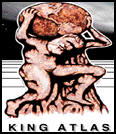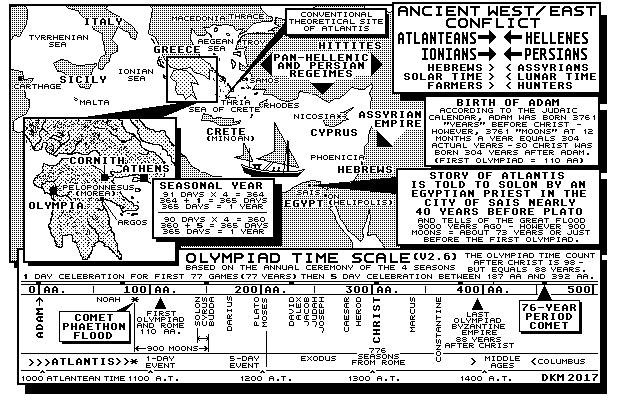

Some would also argue that because no apparent tangible evidence of the Atlantean maritime kingdom has ever been found, the subject is just a fictional parable -- and thus is not to be taken seriously as true history.
However, perhaps the kind of historical evidence that could help prove the existence of the Atlantean Maritime Kingdom may not surface as some lost artifact with the words "Made in Atlantis" labeled on the bottom, but will rise out of certain history books as "literary evidence".
There may also be other types of evidence that could prove Atlantis was a real place in time -- but has not yet been discovered or revealed to the public.
Many have tried to interpret what Plato said about Atlantis and make sense of his story. One of the first was a resentful student of Plato named Aristotle.
It was Aristotle who was quoted as saying "he who invented Atlantis also destroyed it" -- suggesting that his teacher invented the subject.
Aristotle, who later became teacher to the Hellenic general Alexander, probably had no geographical or political knowledge of what lies westward beyond the "Pillars of Hercules" in the Atlantic Ocean -- and because of this, Aristotle may have used portions of Plato's Atlantean story to help support a political argument whereby the apparent Hellenic victory over the western Atlanteans long ago would help drive and expand the political Hellenic empire eastwards into central Asia.


The story of Atlantis is much more than a propagandistic tale about some lost battle between the "western" and "eastern" empires, it is an account of a lost place and time in human history.
Historical textbooks have excluded the reality of the Atlantean Maritime Kingdom because the core site of the antediluvian story has never been found -- and until the ancient capital seaport is conclusively found, modern historians will likely continue to ignore the subject.


There are many reasons why this site has never revealed any signs or clues that would announce its historical importance.
One of the primary reasons is that the site is buried under tons of mud at the bottom of an obscure lake in what is now Central America. And until recently, no visual clues of the 1.25 nautical mile diameter site of the seaport and the nearby canal system has been visible from high altitude photography technology.
The site sits directly atop a major fault-line that divides the American Plate from the Caribbean Plate -- in fact, the epicenter of a 7.5 earthquake in 1976 was less than ten miles from what may be the remnants of this ancient capital seaport.
The cause of that earthquake may be linked to the astronomical and gravitational forces caused by Comet West -- which crashed into the surface of the Sun in 1976.
Perhaps some comets do not have to hit the earth to cause disastrous results. Perhaps a rogue comet hit the sun long ago and, like Plato said about the one-day destruction of Atlantis, caused "a deluge from heaven and great earthquakes" that engulfed the ancient seaport and maritime kingdom.
Plato gives the account of Atlantis together with another ancient story about how the son of Helios named Phaethon, while "driving his father's chariot... burnt up all that was upon the earth" -- and that this tale "has a form of a myth, but really signifies a declination of the bodies moving in the heavens around the earth, and a great conflagration of things upon the earth which recurs after long intervals".
Does this quote sound like some of our ancestors once had knowledge of the astrophysical makeup of our Solar System? Perhaps some scholars long ago knew of comets and how they could have caused problems here on earth.
Perhaps the ancient image of King Atlas holding the heavens on his shoulders represents the lost astrophysical knowledge that some of our ancestors had regarding how certain "heavenly bodies moved around the earth".
Because Plato was the first teacher of collective education at his school called the "Academy", it is ironic that conventional educational facilities throughout western history have generally ignored his work about Atlantis.
Plato's "Academy" was the place where many students learned to read and write stories that were collected from other places beyond the Athenian region. One could say that Plato may have used his students to copy and "publish" not only his philosophical views, but also other stories from abroad -- like the story about the Atlantean seaport and its inhabitants.
Although the Timaeus dialogue mentions the Atlantean subject, it is in the Critias dialogue that Plato really gives extreme detail as to the layout of the lost capital seaport of Atlantis.
One of the many amazing aspects of this lost capital seaport is how it was "carved" out of rocky hill by what Plato describes "as with a lathe" -- suggesting that some sort of massive stone cutting technology was once used to create the rings of land and sea of the seaport.
Moreover, according to Plato, this massive stone cutting technology also was used to carve a series of man-made canals into a surrounding agricultural plain near the capital seaport that extended some fifteen by ten nautical miles before draining into the seaport and another canal path which led to the sea.



Because most sports stadiums of the world are built around a playing field measuring 100-yards, someone, somewhere must of doubled the original value of the original 100-yard dash of the Olympiad games -- thus resulting in the much larger measurement value of the Atlantean seaport during traditional translation projects.
By the way, the first game of the Olympiad games was a foot-race event that measured the length of one stadia -- or about 1/20th of a nautical mile.
Also, because of a numerical misunderstanding during the translation of Plato's work, when he gives the stadia measurement values of the canal system and surrounding agricultural plain of 3000 by 2000 stadia, a new decimal value of 300 by 200 stadia reveals a canal system and plain that is about 15 by 10 nautical miles.
Furthermore, there also exist other numerical examples of how an extra "zero" could have been added to early mathematical translations of ancient writings -- but that's another story for another essay.
So, if one would look on certain maps in the far western Atlantic, say just inland from the western Caribbean Sea, within eastern Central America and between some mountains near Lake Izabal in Guatemala, there exist such a flat swampy plain that could perfectly fit a skewed parallelogram canal system -- measuring 15 by 10 nautical miles, into the area.
It should also be noted that this area in Guatamala is geologically connected to a major faultline which runs through the upper Caribbean Basin -- and helps explain why the place has been destroyed by many earthquakes over time.



The site area in question probably contains more valuable environmental treasures in its current state than could ever be recovered in any "archeological dig" that would stir up the mud in the lake and cause harm to the environment -- so it is hoped that any attempt to recover information from the site area would respect the natural makeup of such a unique biosphere.
If conventional educational facilities would take the time to review the original Timeaus and Critias works by Plato, they may rediscover the many historical treasures from the lost world of Atlantis.